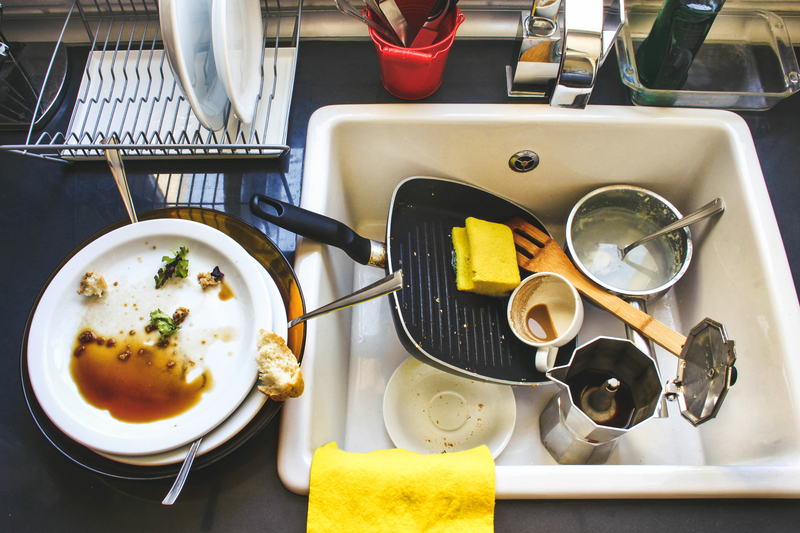Effective Strategies for Freezer Storage
Posted on 11/06/2025
Effective Strategies for Freezer Storage: Maximizing Space and Food Freshness
Proper freezer storage is essential for preserving food freshness, minimizing waste, and making the most of your kitchen space. Whether you're meal prepping, buying in bulk, or simply looking to keep your favorite foods on hand, mastering the art of freezer storage can save time, money, and hassle. This comprehensive guide covers effective freezer storage strategies to help you organize, label, and maintain the nutritional quality of your frozen goods.

Why Freezer Storage Matters
Freezer storage isn't just about tossing leftovers into icy depths and hoping for the best. Without thoughtful organization and technique, you may end up with food that has freezer burn, an overstuffed freezer you can't navigate, or wasted items forgotten at the back. An efficient freezer storage system ensures you can quickly find what you need, manage inventory, and reduce food spoilage.
Benefits of Optimized Freezer Storage
- Extended Shelf Life: Food stays fresher longer when stored properly.
- Reduced Food Waste: Better organization helps prevent waste due to spoilage or forgotten items.
- Saves Money: Buying in bulk and freezing reduces grocery bills.
- Convenience: Meals and ingredients are easily accessible for busy days.
Preparing Foods for Freezer Storage
Before items go into the freezer, it's vital to prepare them correctly to maintain optimal freezer storage quality. This step ensures you retain nutritional content, taste, and texture while preventing cross-contamination or freezer odors.
Best Practices for Pre-Freezing Preparation
- Cool Foods Before Freezing: Always allow hot or warm foods to cool to room temperature. This prevents excess condensation and ice crystals.
- Portion Wisely: Divide food into meal-sized portions. This makes reheating easier and avoids thawing more than you need.
- Blanch Vegetables: Quickly boiling and then plunging vegetables into ice water preserves color, flavor, and nutrients.
- Remove Air: Use airtight bags or containers and remove as much air as possible to avoid freezer burn.
- Wrap Tightly: For items like fish, meat, or bread, wrap tightly in plastic wrap, foil, or freezer paper before sealing in bags.
Choosing the Right Containers
Not all containers are created equal for freezer storage. Selecting proper packaging is crucial to protect food against air, moisture, and odors, contributing to more effective freezer organization and storage.
Types of Freezer-Safe Containers
- Freezer Bags: Heavy-duty zip-top freezer bags save space and secure a tight seal. Label with a permanent marker for easy identification.
- Rigid Plastic Containers: These are ideal for liquid-based foods like soups and stews. Ensure they are labeled "freezer-safe."
- Aluminum Foil and Freezer Paper: Perfect for wrapping meats, breads, and baked goods before placing them inside bags or containers.
- Vacuum Sealers: Removing all air creates optimal conditions for long-term storage and minimizes freezer burn.
Organizing Your Freezer for Maximum Efficiency
Efficient freezer organization strategies can revolutionize your meal prep and shopping habits. Avoid chaos by implementing these techniques:
Layout and Zone System
- Categorize by Food Group: Assign zones for meats, vegetables, fruits, ready-to-eat meals, and baked goods.
- FIFO (First In, First Out): Always place newer items at the back and older ones at the front to encourage rotation and use before spoilage.
- Use Baskets and Bins: Keep loose items in labeled baskets to prevent small packages from getting lost.
- Flat Freezing: Freeze food in thin, flat layers in bags and stack them to maximize vertical space.
Label, Date, and Track Inventory
- Label Everything: Note the content, portion size, and freeze date for every item.
- Maintain a Freezer Inventory Sheet: Keep a list on the freezer or on your phone to track what's inside and when it should be used.
- Use Color Coding: Assign color labels or tape for different food groups for quick identification and access.
Avoiding Freezer Burn and Ensuring Freshness
Freezer burn affects food quality and taste, often resulting from exposure to air. Minimizing freezer burn is a cornerstone of effective freezer storage practices.
Preventing Freezer Burn
- Remove As Much Air As Possible: Use vacuum-sealed bags or press bags flat before sealing.
- Keep Freezer Full but Not Overstuffed: A full freezer retains cold better, but overcrowding restricts airflow, leading to unstable temperatures.
- Seal Containers Properly: Ensure all lids and closures are tightly fastened to prevent air exchange.
- Use Within Recommended Times: While frozen foods last long, best quality is maintained within specific timeframes (e.g., meat: 4-12 months, bread: 3 months).
Smart Defrosting and Thawing Techniques
Proper thawing is vital for food safety and flavor retention in effective freezer storage management.
Best Methods for Safe Thawing
- Refrigerator Thawing: Transfer items to the fridge 24 hours before use for safe, even thawing.
- Cold Water Thawing: Submerge sealed items in cold water, changing the water every 30 minutes. Never use hot water, as it promotes bacterial growth.
- Microwave Thawing: Use your microwave's defrost setting for quick results, but cook immediately after thawing.
- Cook from Frozen: Many meals, like soups and stews, can be reheated directly from the freezer for added convenience.
Storage Timelines for Common Frozen Foods
Knowing how long different foods can be safely stored in the freezer ensures their quality and nutritional value. Here's a quick reference for effective freezer storage timing:
Illustrative Freezer Storage Chart
- Meat (Beef, Pork, Lamb): 4-12 months
- Poultry (Chicken, Turkey): 9-12 months
- Fish (Fatty types): 2-3 months
- Vegetables (blanched): 8-12 months
- Bread and Baked Goods: 2-3 months
- Soups & Stews: 2-3 months
- Fruit: 8-12 months
- Ice Cream: 2-4 months
*Quality may begin to deteriorate after these suggested times, though food remains safe indefinitely if kept frozen at 0?F (-18?C).
Freezer Maintenance Tips for Longevity
Properly maintaining your freezer is integral to effective long-term freezer storage.
Maintenance Steps
- Regular Cleaning: Every 3-6 months, empty and clean the freezer with mild soap and water to avoid odors and ice build-up.
- Monitor Freezer Temperature: Keep your freezer at or below 0?F (-18?C) for best results.
- Defrost If Needed: Manual-defrost freezers should be defrosted as soon as ice becomes more than 1/4-inch thick.
- Check Door Seals: Ensure gaskets are clean, flexible, and seal well to keep cold air inside.
Freezer Storage Hacks: Space-Saving and Access
Creative freezer storage solutions can boost accessibility and space utilization.
Handy Tips for Small and Large Freezers
- Stack and Stand: Freeze soups or sauces flat in bags, then stand them up vertically like files in a box for easy grabbing.
- Muffin Tins and Ice Cube Trays: Great for freezing small portions of stock, broth, sauces, or herbs in oil. Transfer cubes to bags once frozen.
- Lazy Susan or Turntable: Use in deep freezers to rotate items and reduce forgotten food.
- Binder Clips: Attach clips to wire shelves to hang bags, freeing up shelf space below.
Common Freezer Storage Mistakes to Avoid
- Overloading the Freezer: This blocks vents and restricts proper cooling circulation.
- Not Labeling Items: Leads to "mystery meals" and forgotten perishables.
- Putting Warm Food In: Raises internal temperature and can cause other frozen foods to thaw.
- Using the Wrong Containers: Thin plastic or glass not rated for freezing can crack or degrade.
- Ignoring Expiry Dates: Can lead to taste and texture loss.

Sustainable and Eco-Friendly Freezer Storage Practices
In addition to saving money and time, effective freezer storage can support a more sustainable kitchen. Here are simple tweaks for an eco-conscious freezing routine:
- Reusable Containers: Opt for glass or sturdy, BPA-free plastic containers for repeated use.
- Compostable Freezer Bags: Use whenever possible to minimize plastic waste.
- Batch Freeze: Cook and freeze in bulk to reduce cooking energy and food packaging waste.
- Minimal Packaging: Double-wrap only if necessary to prevent waste.
Conclusion: Elevate Your Kitchen Game with Effective Freezer Storage
Implementing these strategies for freezer storage will simplify your kitchen routine, reduce food waste, and ensure your meals are nutritious and delicious whenever you need them. Remember:
- Prep foods properly before freezing.
- Use the right containers and label everything.
- Organize your freezer for easy access and rotation.
- Watch for freezer burn and maintain proper temperatures.
- Thaw food safely and monitor storage times.
Adopting these best practices will help you master the art of freezer storage, offering peace of mind and delicious meals at your fingertips. Begin today and transform your freezer into an organized, efficient asset in your kitchen!





